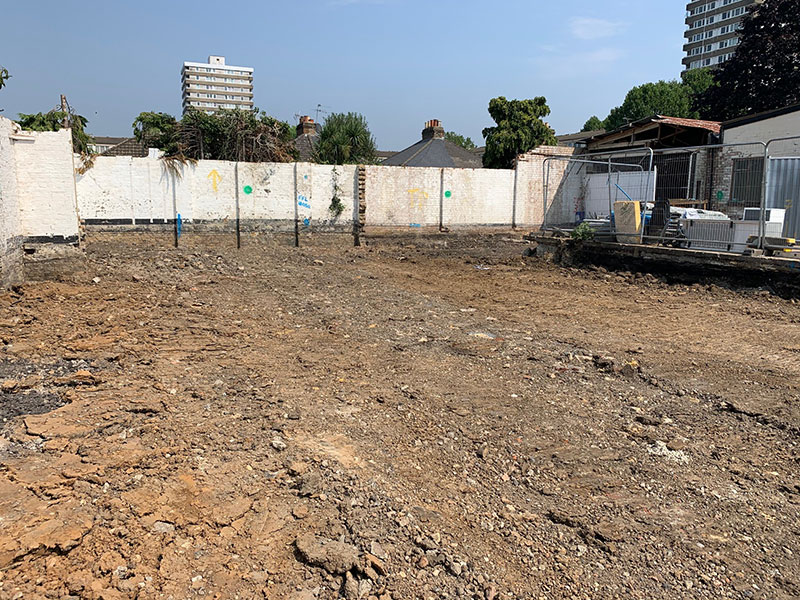What is trace asbestos contamination in soil? Should I be Concerned?
Today, the very mention of the word “asbestos” conjures up the image of health hazard; the naturally occurring mineral is notorious due to the well-established link between inhalation or ingestion of the substance, and a heightened risk of serious diseases such as mesothelioma and lung cancer.
However, while such health risks have always been present where someone could breathe in asbestos, these risks were not always widely known about.
In fact, for the bulk of the 20th century, asbestos was widely used in the UK for a broad range of products, including in such industries as shipbuilding and construction.
With the importation and use of asbestos having only been banned in the UK in 1999, the material remains present in many domestic, commercial, and public buildings up and down the country, to this day. Consequently, stringent regulations have been put in place to help manage and minimise the risk that asbestos fibres could present to human health.
However, the fact that the majority of UK asbestos regulation now in place focuses on asbestos contained within the fabric of buildings, raises an important question: what about when traces of asbestos find their way into soil?
In this article, then, we decided to take a closer look at the subject of trace asbestos contamination in soil, how and why it occurs, and the steps that need to be taken in order to manage and reduce the risks.
What is meant by ‘trace asbestos contamination in soil’?
As we touched on above, asbestos was once extremely widely used in the UK construction industry. For much of the 20th century, this fibrous silicate mineral was incorporated into many of the most frequently used products in the building trade, ranging from asbestos insulating board and asbestos cement products to textured coatings, lagging, and roofing felt.
When we talk about ‘trace asbestos contamination in soil’, however, we are referring to a phenomenon that hasn’t been the greatest area of focus for asbestos regulation and management to date: the presence of asbestos fibres in soil at low concentrations.
Asbestos was widely used in construction materials and other products due to such strengths as its relative affordability, availability, strength, and fire resistance. However, it took until around the 1970s for the wider public to become more aware of the potentially serious health consequences of inhaling asbestos, including the development of such conditions as mesothelioma, asbestos-related lung cancer, and asbestosis.
Trace asbestos contamination in soil can occur from various sources, such as the release of asbestos fibres from deteriorating building materials, or the deposit of asbestos-containing waste materials in landfills.
Even low levels of asbestos in soil can pose a health risk if the fibres become airborne, given the increased likelihood that this presents of someone nearby inhaling the fibres. This makes it important to take appropriate measures to help prevent anyone from being exposed to asbestos fibres in soil.
These measures could include the avoidance of activities – such as digging or construction work – that disturb soil potentially containing asbestos. In addition, it will be necessary for whoever is responsible for a given site to put in place appropriate safety procedures whenever there is a need to directly handle soils or materials that may contain asbestos.
If you suspect that you may have breathed in or ingested asbestos fibres, it is crucial to seek medical attention as soon as possible.
What are the causes of trace asbestos contamination in soil?
There is a range of ways in which soil at a given site can potentially become contaminated with trace elements of asbestos. One of the most obvious ways in which asbestos might have ended up in the ground, is if a property containing asbestos was demolished.
Particularly in the era many decades ago when asbestos was still legal to use in the UK, there was not the same strict regulation in place to help control the risks of asbestos to health. Structures containing asbestos might have even been demolished in the past without those responsible being aware that asbestos was present in the building.
Traces of asbestos might also be present in soils due to such circumstances as deteriorating building materials and asbestos-containing waste in landfills, as well as fly-tipping, farmers burying asbestos on their own land, and even underground services such as water and soil pipes.
While asbestos products such as floor tiles, rope seals, or lagging may be found relatively intact in the ground – and therefore be easier to spot – this will not always be the case. There can also be scope for asbestos-containing materials (ACMs) to deteriorate over time, with fragments potentially breaking off and becoming incorporated into the soils, where they are likely to be almost invisible.
Even poorly executed asbestos removal works can lead to trace asbestos contamination in soil. This was particularly likely to happen many decades ago, when people managing asbestos in buildings often did not have the same understanding of the risks – and the necessity of careful management – as many people do now.
Once asbestos is present in soil, many of the smaller fragments may not be easily detectable by the human eye. This presents the risk of someone easily disturbing soil in which asbestos might be present, and as a consequence, heightening their chances of serious disease at a later date.
Prevention and safety measures for trace asbestos contamination
So, now that you appreciate how dangerous traces of asbestos in soil can potentially be, what should you do if you find or suspect the presence of asbestos at a site for which you are responsible?
Here are some simple steps to take.
- Avoid exposure to the potential asbestos fibres. Although you might be far from sure at this stage whether the suspected material is asbestos, it is safer to assume that the material is indeed asbestos, until and unless proven otherwise.
- Avoid activities that disturb the soil. This might seem like obvious advice to give, but we aren’t necessarily only referring to more obviously intrusive activities, such as excavation or construction. If the suspected asbestos is relatively close to the surface, even traffic or the use of lawn mowers could cause disturbance of the material.
- Consult a professional asbestos consultant, and have testing carried out. Arranging for appropriate soil testing or a contaminated land survey will enable you to identify the location, extent, condition, and type of any asbestos present. This information, in turn, will allow you to assess the risk and decide on suitable actions to take, depending on such aspects as any plans for the land, and how the site is likely to be used in the future.
- Follow the expert advice and comply with appropriate safety procedures. Our own professionals here at Oracle Solutions are highly experienced in providing asbestos advice in relation to a wide range of premises and circumstances. We are accredited and respected asbestos consultants, so you can have the utmost confidence in the advice and guidance that we give, and which can help minimise the likelihood of asbestos exposure on your site.
Taking responsible action on asbestos in soil can help protect public health
Given the difficulties involved in detecting asbestos fibres in soil in the first place, and the health risks that can arise because of this, it is crucial to understand how trace asbestos contamination can occur in soil, and how to prevent it. Proactive steps will help you keep your own site as safe as possible.
The issue of asbestos in soil has not attracted as much public attention as the matter of asbestos contained within the fabric of buildings. However, it is vital that individuals and organisations are aware of it, and how to manage its risks.
Email or call our team at Oracle Solutions today, and we will be pleased to provide help and assistance to ensure you take appropriate steps to prevent asbestos exposure on your site. This, in turn, can go a long way to safeguarding broader public health.

Written by Callum McDonald
Callum McDonald is an expert in asbestos quality management, ensuring rigorous adherence to regulations and high-quality standards in removal projects. His focus on enhancing quality and client satisfaction makes him a crucial asset in safety and compliance within the field. Callum's expertise in technical support and oversight of licensed works underscores his commitment to excellence in asbestos management, providing invaluable guidance to clients in this specialised area.

